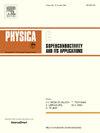The compound Ca2RuO4 within the Zaanen–Sawatzky–Allen approach
IF 1
3区 物理与天体物理
Q4 PHYSICS, APPLIED
Physica C-superconductivity and Its Applications
Pub Date : 2025-05-07
DOI:10.1016/j.physc.2025.1354725
引用次数: 0
Abstract
Recent advancements in the application of the Zaanen–Sawatzky–Allen (ZSA) theory have significantly expanded its scope in a wide range of materials beyond standard transition metal compounds, from high-temperature superconductors to topological insulators and low-dimensional systems. The combination of computational tools, such as dynamical mean field theory, along with experimental insights, allowed to further refine the theory, making it a valuable framework for classifying and predicting the electronic properties of large classes of complex materials with correlated electrons. Here, we extend the application of the ZSA approach to CaRuO, a widely studied system where, differently from what happens in the transition metal compounds usually analyzed in this context, the relevant excitations close to the Fermi energy involve electrons coming from partially filled shells, those of ruthenium atoms, rather than ones.
Zaanen-Sawatzky-Allen方法中的化合物Ca2RuO4
zaanen - sawatzsky - allen (ZSA)理论应用的最新进展已将其应用范围大大扩展到标准3d过渡金属化合物以外的各种材料,从高温超导体到拓扑绝缘体和低维系统。计算工具的结合,如动态平均场理论,以及实验见解,允许进一步完善理论,使其成为一个有价值的框架,用于分类和预测具有相关电子的大型复杂材料的电子特性。在这里,我们将ZSA方法的应用扩展到Ca2RuO4,这是一个被广泛研究的体系,与在这种情况下通常分析的过渡金属化合物中发生的情况不同,靠近费米能量的相关激发涉及来自部分填充的4d壳层的电子,即钌原子,而不是3d壳层的电子。
本文章由计算机程序翻译,如有差异,请以英文原文为准。
求助全文
约1分钟内获得全文
求助全文
来源期刊
CiteScore
2.70
自引率
11.80%
发文量
102
审稿时长
66 days
期刊介绍:
Physica C (Superconductivity and its Applications) publishes peer-reviewed papers on novel developments in the field of superconductivity. Topics include discovery of new superconducting materials and elucidation of their mechanisms, physics of vortex matter, enhancement of critical properties of superconductors, identification of novel properties and processing methods that improve their performance and promote new routes to applications of superconductivity.
The main goal of the journal is to publish:
1. Papers that substantially increase the understanding of the fundamental aspects and mechanisms of superconductivity and vortex matter through theoretical and experimental methods.
2. Papers that report on novel physical properties and processing of materials that substantially enhance their critical performance.
3. Papers that promote new or improved routes to applications of superconductivity and/or superconducting materials, and proof-of-concept novel proto-type superconducting devices.
The editors of the journal will select papers that are well written and based on thorough research that provide truly novel insights.

 求助内容:
求助内容: 应助结果提醒方式:
应助结果提醒方式:


